Summary of Oscar Niemeyer
Oscar Niemeyer - the so-called "concrete poet" - is one of the most influential architects of the 20th and 21st century. He is responsible for the design of innovative civic buildings in Brazil, and especially its new capital city, Brasília. A one-time assistant to the arch modernist, Le Corbusier, he moved beyond his mentor's "straight" and functional model to create modern structures defined by spectacular undulating lines. This signature innovation, coupled with his efforts to push the aesthetic limits of reinforced concrete, saw his name become synonymous with Brazil's post-colonial architectural identity. His reputation was further strengthened on the back of important works across the Americas, Europe, and Africa. During his long life, he received numerous awards and accolades, with the most prestigious, the Pritzker Prize (in 1988), validating his status as one of the world's most influential architects.
Accomplishments
- Probably Niemeyer's most significant achievement was his design for the construction of a whole new city, Brasília. As the country's new federal capital, Brasília signified the country's modernity and demonstrated that Brazil was a progressive country capable of creating an architectural identity that would resonate on the international stage. He said of the Brasília project, "We were beginning to show the Old World that there wasn't much they could teach us Latin Americans".
- Niemeyer first signaled his ambition to refigure the Brazilian architectural landscape with his free-flowing Pampulha Architectural Complex. Situated around an artificial lake, and completed in the early 1940s, it included a clutch of designs: from a church to a casino; a dance hall to a mayoral retreat. The Pampulha complex demonstrated a lucid modernity; a style defined by a combination of flowing lines and structural precision.
- Niemeyer was a committed member (and later president) of the Brazilian Communist Party (PCB). However, Niemeyer's politics were not apparent in his buildings and he was vocal in his criticism of bland and functional communist architecture (once telling an audience of Soviet communists in Moscow "your architecture is awful"). For his design for the headquarters for the French Communist Party, for instance, Niemeyer created a futuristic building set-off with an eleven-meter-high dome clad in thousands of light-diffusing anodized aluminum blades. On its completion, the French President Georges Pompidou quipped that the building "was the only good thing those Commies had ever done".
- One of Niemeyer's most striking and original later designs was for the Niterói Contemporary Art Museum (1996). By this stage in his career (he was 89 years old) some critics, had dismissed him as a "spent force". But he defied all expectations with a museum that resembled a flying saucer perched precariously on the rocks overhanging Rio de Janeiro's spectacular Guanabara Bay. Professor of Architecture, João Masao Kamita, proclaimed, "There was no way of denying it, the 'old man' had returned to form. Niterói is an impressive work of architecture, a perfect symbiosis between built form and landscape [and] without recent precedent".
The Life of Oscar Niemeyer
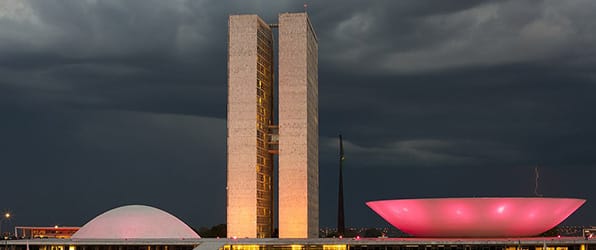
Architecture professor João Masao Kamita writes: "Niemeyer's architecture gives the impression of inhabiting an ideal place, in which tensions are pacified and forms find their natural place [...] In fact, it points to an inevitable utopia, in which everyone would be able to participate and have access to beauty".
Important Art by Oscar Niemeyer
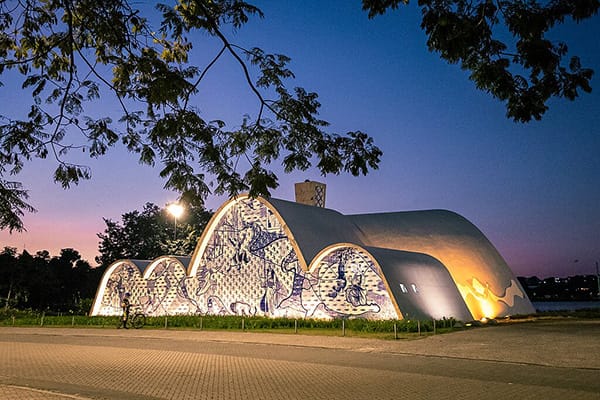
Saint Francis of Assisi Church
Early in his career, Niemeyer was approached by Juscelino Kubitschek, mayor of Belo Horizonte, the capital city of Minas Gerais, to design several buildings including a casino, ballroom, yacht club, and golf club for Pampulha, a planned suburb just north of the city. Niemeyer was also tasked with designing the community's church, which would become one of the most famous buildings of his career, and the one with which he defined his uniquely-Brazilian, modernist aesthetic which boasted an innovative use of reinforced concrete. He highlighted the inherent plasticity of this material by creating a rippling series of parabolic vaults, fusing walls and ceilings into one continuous, undulating surface. His idea for this hangar-like form came from French poet Paul Claudel, who wrote that "A church is God's hangar on earth". At the same time, he saw the rippling form as reflecting the mountains that stand as a backdrop to the site. The flat walls of the church were then covered in "azulejo" tiles by Brazilian painter Candido Portinari (on the front end), and tile murals by Brazilian painter and muralist Paulo Werneck (on the back end), all of which are blue and white. The church interior is warm, with wood lining the curved walls and ceiling.
With the Saint Francis of Assisi Church (one of the first listed "modern" architectural monuments in Brazil), Niemeyer relished the opportunity to, in his words, "challenge the monotony of contemporary architecture, the wave of misinterpreted functionalism that hindered it and the dogmas of form and function that had emerged. [...] I deliberately disregarded the right angle and rationalist architecture designed with ruler and square to boldly enter the world of curves and straight lines offered by reinforced concrete. [...] This deliberate protest arose from the environment in which I lived, with its white beaches, its huge mountains, its old baroque churches and the beautiful suntanned women". Indeed, throughout his career, Niemeyer identified the curve as a regional architectural element that could define modern Brazil. However, his church proved so revolutionary, and so shocking to local church authorities (archbishop Cabral of Belo Horizonte calling it "the devil's bomb shelter", and a later mayor of Belo Horizonte petitioned to have it demolished entirely), that, although completed in 1943, it was not consecrated for another 16 years. In 2016 its future was secured when it was awarded UNESCO world heritage site status.
Belo Horizonte, Brazil
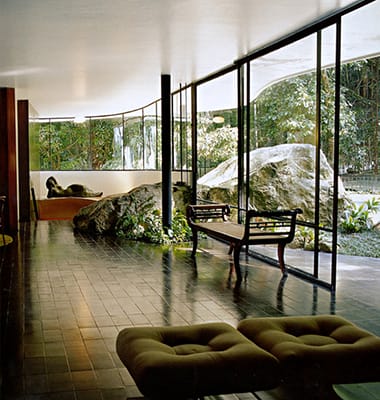
Casa das Canoas
Although he built several domestic residences over the course of his career, Niemeyer's most personal, and most famous, house was the one he designed for himself his family in the Barra de Tijuca suburb of Rio de Janeiro. The Casa das Canoas is a two-story home nestled into the mountainous terrain, with a distant view of the ocean. The lower floor contains the bedrooms, while the second floor, which contains the living areas, dining room, and kitchen, inspired by German-American architect Ludwig Mies van der Rohe, sits under an irregular, flat concrete roof supported by thin metal columns, with glass walls. The house did not feature a separate entrance for servants, "a scandalously egalitarian flourish for the Brazil of the period' comments the architectural historian, Carolina A. Miranda. An enormous rock, to which the staircase is attached, and which juts up through the entire house, emerging by the pool, creates a sense of continuity between the two levels and the pool area. As Torres notes, the rock is not "an uncomfortable intruder. [...] The architecture envelops it and lets it penetrate it in a profound communion". The overall design of the home creates a sense of harmony, fluidity, and openness, blending the interior with the landscape outside.
Niemeyer later explained that with this project, "My concern was to design the residence freely and to adapt it to the unevenness of the field without modification, making it into curves, so the vegetation could enter them without separation or departure from the straight line. And I created the living spaces to be in a shadow, to avoid the need for curtains and allow the house to be transparent, as I preferred". Upon visiting the Casa das Canoas, German-American architect Walter Gropius (with whom Niemeyer often clashed when it came to their architectural philosophies), told Niemeyer that it was aesthetically beautiful, but "not reproducible", which infuriated Niemeyer.
As Torres notes, "the design concept, the use of materials such as concrete and glass, the exploitation of the irregularities of the ground, the relationship with nature: all the themes dear to the Brazilian architect are condensed in this building with sinuous shapes [...], which is subject to nothing but the will of Niemeyer and the nature surrounding it". Architecture writer Sofia Fonseca, meanwhile, recognizes the Casa das Canoas as "the turning point" in Niemeyer's career, when he began to "seek new ways of using concrete and using the external environment as a project-shaping element".
Rio de Janeiro, Brazil
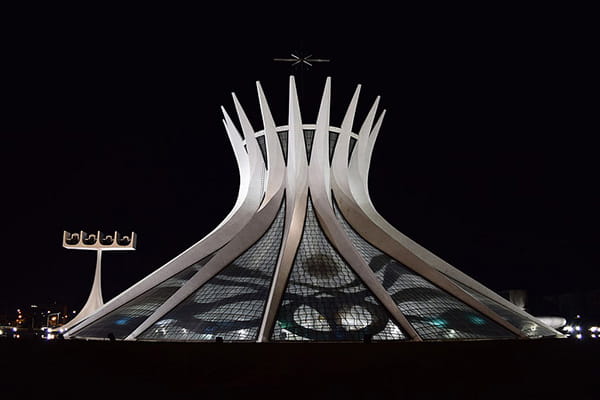
Cathedral of Brasilia
In the mid-1950s, Niemeyer was approached by newly-elected Brazilian president Juscelino Kubitschek, to design an entirely new capital city, Brasilia, on virgin terrain at the center of the country. Architecture critic Nicolai Ouroussoff writes that, "Niemeyer got the opportunity to create his own poetic vision of the future on a monumental scale". Ouroussoff notes that although the overall design of the city is credited to Niemeyer's former mentor and employer, Lúcio Costa, "it was Mr. Niemeyer who gave Brasília its sculptural identity. The speed with which the city was created, between 1956 and 1960, reinforced its image as a utopian dream that had sprouted magically out of a primitive landscape. Its crisp, abstract forms seemed to sum up the aspirations of much of the developing world: the belief that modern architecture and the faith in technological progress that it embodied could help create a more egalitarian society".
This ethos is exemplified by Niemeyer's design for the Brasilia Cathedral, another striking church built by the atheistic architect. Architecture writer Eric Allen explains that "The swooping columns of the Cathedral [...] form a coronal shape called a hyperboloid structure. The Roman Catholic cathedral, most of which is set underground, is surrounded by a reflecting pool, under which worshipers pass to enter the building. It [...] is complemented by a similarly shaped bell tower and bronze sculptures of the four Evangelists by Dante Croce". Journalist Chris Hall continues that "The economy of its structure [...] is simply breathtaking. The massive triangular coloured stained glass windows appear ethereal within its embrace", while architecture professor, João Masao Kamita, opines that the structure creates "a sense of spatial openness and transparency that is unusual for a sacred space."
The Cathedral, and indeed Brasilia as a whole, was met with mixed criticism. Soviet astronaut Yuri Gagarin said of his visit to Brasilia in the early 1960s, "I had the impression I had landed on another planet". Critic Robert Hughes described the city more harshly, calling it a "utopian horror". Niemeyer stated in a 2005 interview with New York Times critic Michael Kimmelman: "You may not like Brasília, but you can't say you have seen anything like it - you maybe saw something better, but not the same. I prefer Rio, even with the robberies. [...] But people who live in Brasília, to my surprise, don't want to leave it. Brasília works. There are problems. But it works. And from my perspective, the ultimate task of the architect is to dream. Otherwise nothing happens". Arts journalist Carolina Miranda recognizes that "the construction of Brasília might have seemed like a wildly authoritarian gesture. But, for Brazil, it was also a way of shaking off the legacy of colonialism. [...] The project wasn't simply about putting up a few grandiose buildings in the middle of the savannah, it was about rejecting northern paternalism and showing that Brazil was capable of devising its own design solutions - ones that could resonate at an international level".
Brasilia, Brazil
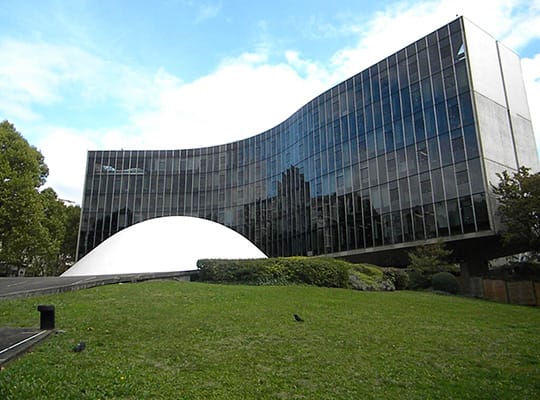
Headquarters of the French Communist Party
While living in self-imposed exile in Paris, Niemeyer designed the headquarters for the French Communist Party, at 2 Place du Colonel Fabien in the 19th arrondissement. The building is rectangular, yet simultaneously curved and undulating, made of concrete and wrapped in a tinted glass curtain in which, according to the architect, "the sky of Paris is reflected". A white concrete dome, where the party's National Council sits underground, according to Niemeyer, was meant to represent a pregnant woman. Architecture writer Evan Pavka notes that "Having worked with Le Corbusier on the 1952 United Nations Building in New York and recently finished the National Congress as well as additional iconic government buildings in Brasilia, Niemeyer was no stranger to the intimate relationship between architecture and political power". As a committed communist himself (and a committed atheist) the project was no doubt of greater personal significance to him than his church projects, say. In 1963, in a presentation he gave to an audience of Soviet communists in Moscow, Niemeyer stated "On the politics, I'm with you. But your architecture is awful". And as a new denizen of Paris, he had his chance to offer a revised vision of communist architecture.
Niemeyer later explained that "In the French Communist Party Headquarters, I demonstrated the importance of maintaining harmony between volumes and spaces on the exterior, which explains why the great workers' hall is located underground". The interior of this hall is futuristic, with the inside of the eleven meter-high dome clad in thousands of light-diffusing anodized aluminum blades, and the floor covered in the same vibrant green carpeting that extends throughout all the subterranean spaces (which also include exhibition spaces and a bookshop). In March 1972, an article in The Architectural Review called the building "probably the best building in Paris since Le Corbusier's Cité de Refuge for the Salvation Army". Even former French President Georges Pompidou stated that the building "was the only good thing those Commies had ever done".
Paris
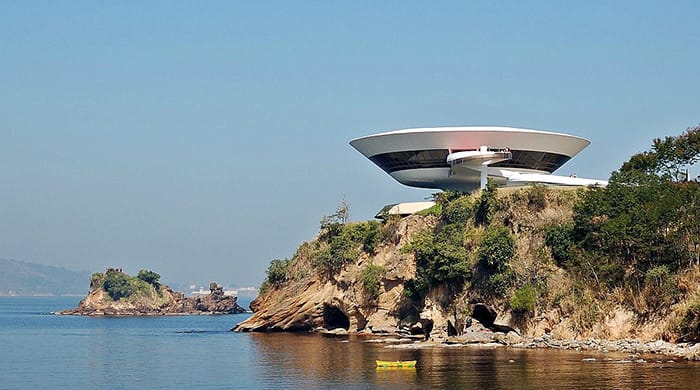
Niterói Contemporary Art Museum
Niemeyer once explained, "When I started to design the Museum of Modern Art for Niteroi, I already had an idea in mind. An abstract circular form above the landscape, and the site free of other constructions to better emphasize the building. I did not want to repeat the usual solutions of a cylinder above another, but to move in the direction of the design for the Caracas Museum [a design by Niemeyer dating back to 1954], creating a line that would rise with curves and straight lines from the ground up to the roof. The exhibition hall would be surrounded by straight walls - I did not want it glazed - but with exits for the external gallery that would encircle it, integrating it in the magnificent panorama". Thus was born his plan for the Niterói Contemporary Art Museum, which appears life a flying saucer perched on the rocks above Rio de Janeiro's scenic Guanabara Bay.
Professor of Architecture, João Masao Kamita, writes that "For my generation, who lived through Postmodernism in the late 1980s, Niemeyer was an uncomfortable figure. His position and historical importance was indisputable, but in recent times, his work was becoming repetitive, as if he had nothing more to add, other than the hedonistic exercise of self-reference. We became weary of the curves and redundant formalism. [...] Yet in 1996, the Niterói Contemporary Art Museum appeared. There was no way of denying it, the 'old man' had returned to form. Niterói is an impressive work of architecture, a perfect symbiosis between built form and landscape, without recent precedent". Architecture writer Diksha Sharma adds that "The whole building is in rhythm with its environment and the structure is so elegantly harmonized with nature, it looks like something sprouting from the ground. [...] Simplicity is what makes this structure feel enormously natural despite it being a giant concrete erection".
Niterói, Brazil
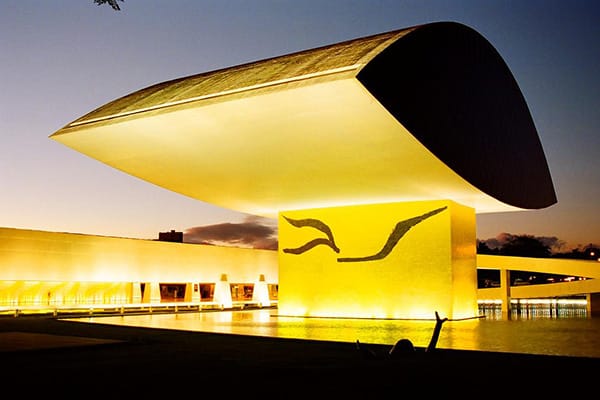
Museu Oscar Niemeyer (Oscar Niemeyer Museum)
The Oscar Niemeyer Museum (MON) is the largest art museum in Latin America. It covers roughly 35,000 square meters of built area with more than 17,000 square meters of exhibition space (devoted primarily to the work of Brazilian artists) and was designed by Niemeyer in the later stages of his career. It comprises two buildings. The first, completed in 1978, is clean and rectangular and follows in the tradition of the International Style, and was originally the headquarters of the Education Institute of Paraná. The second building, or annex, was completed in 2002, at which point the site was transformed into the Museu Oscar Niemeyer. This second building assumes the form of an enormous human eye, perched on a pillar above a reflecting pool, giving rise to the nickname, "Museu do Olho" ("Eye Museum").
The museum features several signature Niemeyer design features, including curved ramps, white concrete, and brightly-colored painted murals, and dramatic nighttime lighting. Niemeyer once stated, "I am not attracted to straight angles or to the straight line, hard and inflexible, created by man. I am attracted to free-flowing, sensual curves. The curves that I find in the mountains of my country, in the sinuousness of its rivers, in the waves of the ocean, and on the body of the beloved woman. Curves make up the entire Universe, the curved Universe of Einstein". Architecture professor João Masao Kamita writes, "Critics have characterised the work of Niemeyer using terms such as 'lightness', 'grace' and 'volumetry'. Yet, to uphold such qualities implies a paradox: they depend on the sculptural properties of reinforced concrete, but in order to achieve lightness and grace, they must elevate from the resistances of matter, erase the loadbearing forces and dissolve the weight in the white light that resonates on sharply profiled geometric surfaces".
Curitiba, Paraná, Brazil
Biography of Oscar Niemeyer
Childhood
Oscar Ribeiro de Almeida Niemeyer Soares Filho (known simply as Oscar Niemeyer) inherited his surname from his German Brazilian grandmother. He was one of six siblings. His father was a graphic artist, and his paternal grandfather was a judge in Brazil's supreme court. Niemeyer was primarily raised by his maternal grandparents, in the quiet, upper-middle-class district of Laranjeiras in Rio de Janeiro (on a street that would later be named in honor of his grandfather). He once recalled "When I was very little, my mother said I used to draw in the air with my fingers. I needed a pencil. Once I could hold one, I have drawn every day since". Niemeyer spent his youth as a typical young "Carioca" (a demonym that denotes people originating from the streets of Rio de Janeiro) in that he assumed a somewhat carefree and bohemian life. Niemeyer was a good student, however, and graduated from Barnabitas College in 1923. When he was twenty-one, and before he entered higher-education, Niemeyer married Anita Baldo, the daughter of Italian immigrants. (They had one daughter, Anna Maria, and remained married until Anita's passing in 2004.)
Education and Early Training
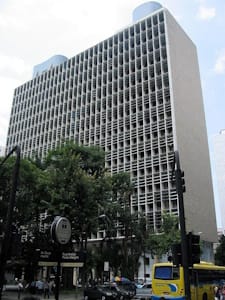
Niemeyer attended the Escola Nacional de Belas Artes at the Federal University of Rio de Janeiro. In 1931, while still a student, he began work as an intern for the Brazilian modernist architect Lúcio Costa. He graduated in 1934 with a degree in Architecture and Engineering. In 1936, Niemeyer (still just 29 years of age) joined a team of Costa, Le Corbusier, Affonso Eduardo Reidy, Carlos Leon, Jorge Moreira and Ernani Vasconcellos to design the headquarters of the Ministry of Education and Health in central Rio de Janeiro. Niemeyer worked initially as Le Corbusier's draftsman but suggested important changes to his designs (once the famous Swiss-French architect had left Brazil). Costa was so impressed with Niemeyer's modifications he appointed him the project's lead architect. The building, a horizontal bar that intersects a vertical blade, was completed in 1945, became the cornerstone of modern Brazilian architecture and attracted attention within the professional architectural world. Niemeyer continued to work at his father's typography house, and as a draftsman for a number of local architecture firms.
Niemeyer also maintained his association with Costa's practice, initially on an unpaid basis. Architectural critic Romullo Baratto called their relationship "a professional partnership that would last decades and result in some of the most important works in the history of modern architecture". Niemeyer also worked with Costa on the plans for the Brazilian Pavilion at the New York World's Fair of 1939-40. Then-mayor of New York, Fiorello La Guardia, was so impressed by the design that he awarded Niemeyer the "keys to New York City".
Niemeyer's first solo projects were for the Grand Hotel in Ouro Preto (1940), and, in 1941, he began work on a free-flowing complex of buildings, the Pampulha Architectural Complex. The complex including a casino, dance hall, restaurant, yachting club, and mayoral retreat, situated around an artificial lake for Pampulha, a planned suburb north of Belo Horizonte, Minas Gerais. The complex was also home to what would become one of Niemeyer's signature structures, the Saint Francis of Assisi Church. One of the first listed Modern structures in Brazil (and today a UNESCO world heritage site), the Assisi, which saw the architect shape reinforced concrete into a series of undulating surfaces, signaled a radical departure from the dominant Baroque style of Brazilian church design.
The Pampulha project overall announced what would be Niemeyer's design trademarks: "I consciously ignored the highly praised right angle and the rational architecture of T-squares and triangles, in order to wholeheartedly enter the world of curves and new shapes made possible by the introduction of concrete into the building process", he said. And while the Roman Catholic authorities protested against the avant-garde leanings of the Assisi Church (it would be 16 years before the church was officially consecrated), many critics praised the Pampulha complex's "beautiful, sensual curved surfaces, which evoke a myriad of emotions.
Three years after the Pampulha project, Niemeyer completed his first domestic residence, which architecture critic Nicolai Ouroussof describes as "a simple modern box resting on slender columns on a mountainside overlooking the magnificent Rodrigo de Freitas lagoon" and that he was already "beginning to develop a distinctive architecture of flowing lines, structural lightness and an open relationship to natural surroundings". In 1947, Niemeyer worked once again in New York City, assisting in the planning of the new United Nations building. However, during his lifetime Niemeyer did relatively little work in the United States because of his close affiliation with the Brazilian Communist Party (PCB) which he joined in 1945 (and later served as president between 1992-96). He was denied work visas on two occasions: in 1947, when he was invited to teach at Yale University; and in 1953 when he was to be appointed dean of the Harvard Graduate School of Design.
Mature Period
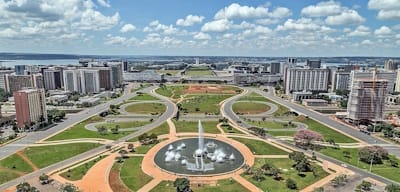
In the early 1950s, Niemeyer worked on several projects, including residential and apartment buildings in cities around Brazil, as well as the Museum of Modern Art in Caracas, Venezuela (1955). In 1955 he founded, Módulo, one of Brazil's most influential publications, covering topics ranging from architecture to design, and Brazilian culture at large. The following year, Juscelino Kubitschek was elected president of Brazil, and proposed a radical plan: the construction of a city, Brasília, which would to be the country's new federal capital. Kubitschek personally selected Niemeyer to design the city's buildings, and Costa won a competition (at Niemeyer's suggestion) to design the urban planning. Brasilia was to be the world's first major city founded wholly on modernist principles and aesthetics. Baratto writes, "The collaboration of Costa and Niemeyer [with input from structural engineer, Joaquim Cardozo, and landscape designer Roberto Burle Marx] gave the world something entirely new: the first major city designed entirely on the basis of modernist principles of functionality and aesthetics". Between 1956-61, Niemeyer personally designed the President's Palace, the Brasília Palace Hotel, the Ministry of Justice building, the presidential chapel, and the cathedral.
Brasília was constructed between 1956 and 1960, when it was officially inaugurated (on April 21, 1960). Writing in 2012 (on the occasion of his death) for Vanity Fair, author and architectural critic Paul Goldberger wrote, "That Brasilia is anything but a utopia is, of course, not news. With its wide boulevards and buildings set down in open space like pieces of abstract sculpture, it is hard to imagine a place less attuned to what we now consider the key elements of a workable city. But if you go to Brasilia, you know you will not find a place to walk; it is far better to put aside for a moment the knowledge that cities ought to be made of streets, and take Niemeyer's exquisite, sumptuous structures for what they are: objects of beauty in which people can be, and often are, inspired to believe in the power of architecture". Architectural historian Carolina A. Miranda adds, however, that, "The buildings were breathtaking; the city, wildly futuristic. But the monumental scale of Brasília - in which a handful of powerful men controlled the city's entire skyscape - hardly seemed to jibe with Niemeyer's collective [communist] ideals". (In 2017 Brasília was named "City of Design" by UNESCO, joining it to its "Creative Cities Network" (UCCN), an intercity program designed to promote cooperation among cities around the world which have recognized culture and creative scope.)
On completion of the Brasília project, Niemeyer returned to private practice. In 1963, he won the Lenin Peace Prize (given to prominent Communists who are not Soviet citizens). He counted Cuban president Fidel Castro, Venezuelan president Hugo Chávez, and Brazilian senator and secretary-general of the Brazilian Communist Party (PCB), Luís Carlos Prestes amongst his closest friends. However, things became difficult for him when a military dictatorship was established in Brazil on April 1, 1964 (and lasting until 1985). In 1965, he resigned from the University of Brasília in protest of the government's treatment of academic institutions. Miranda writes, "An outspoken leftist and a long-time member of the Brazilian Communist Party, Niemeyer designed the building for the army in 1967 - three years after a right-wing military regime had taken over Brazil in a coup d'état, and the same year he went into self-imposed exile in Europe. In fact, he was working for the very institution that had made his life miserable since the 1964 coup: ransacking his office, hauling him in for questioning, jailing and torturing his friends, and making it difficult for him to work in Brazil. He lost the commission to build Brasília's airport after the air force minister declared that 'the place for communist architects is in Moscow'".
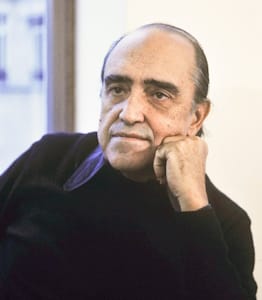
In 1968, Niemeyer returned to Brasilia to design the Ministry of Defense building. The same year, he began lecturing at the University of Rio de Janeiro. However, in 1969 he left the country altogether, living in Paris (where he opened an office on the Champs-Elysées, and also ventured into furniture design), while also spending time in Israel, Cuba, and the Soviet Union. Some of his projects of the 1960s included an urban area in Grasse, near Nice, France, and a new building for the French Communist Party in Paris. Goldberger writes, "Niemeyer's architecture of exuberance was all the more striking because his politics were so far away from the lush, indulgent world that his buildings suggest. He was a lifelong communist, with a serious commitment to left-wing politics far greater than that of any of his peers among the world's major modernist architects, who often tend to be sanctimonious about design and pragmatic about politics. You could almost say that, for Niemeyer, it was the other way around: he kept his somber idealism for the political realm, his pleasure for architecture alone". During his period of nomadic exile he designed the International Permanent Exhibition Centre in Tripoli, Lebanon (1962), and Constantine University (now Mentouri University) in Constantine, Algeria (1969).
Late Period and Death
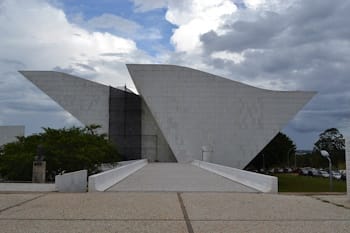
Once the twenty-year military dictatorship had come to an end in 1985, Niemeyer returned to his homeland and began work on a small number of memorials. Having already designed the Memorial Juscelino Kubitschek (1980), a memorial/museum dedicated to the 24th President of Brazil (Kubitschek) who ordered the construction of Brasilia, he followed in 1985 with The Tancredo Neves Pantheon of the Fatherland and Freedom, also in Brasília. The Pantheon is dedicated to the honour of national heroes and was conceived of in the wake of the unexpected death in 1984 of Tancredo Neves, the first elected President of the new Republic (who died before taking office). He followed in 1987, again in Brasília, with the Memorial for the Indigenous People. Featuring a spiral design, it was conceived of by Niemeyer in recognition of the circular houses of the Yanomami Amazonian Indians (an indigenous peoples living in the rainforest regions between Brazil and Venezuela).
In 1988, the Oscar Niemeyer Foundation, dedicated to architectural preservation and research, was founded. In the same year Niemeyer won the Pritzker Architecture Prize (considered the "Nobel Prize of architecture"), and the following year, received the Prince of Asturias Award of Arts. Niemeyer's Latin America Memorial Complex in São Paulo, built to promote the social, cultural, political, and economic integration of Latin America, was inaugurated in 1989. Niemeyer continued to maintain his studio in Rio de Janeiro, and designed buildings including the Catedral Militar, Igreja de N.S. da Paz, in Brasilia (1994), and the Museum of Contemporary Art, in Niterói (1996).
The new millennium saw the opening of the Oscar Niemeyer Museum in Curitiba (2002). In 2004, the same year as he won the Japan Art Association's Praemium Imperiale prize for architecture, Niemeyer's wife, Annita, passed away (aged ninety-three). He was remarried to his secretary of many years, Vera Lucia Cabreira in 2006. On the occasion of his 100th birthday (December 2007) Russian President Vladimir Putin awarded Niemeyer the Order of Friendship (a Russian state decoration given to Russians and foreign nationals who have worked toward the improvement of relations between Russia and other nations). Three years later a new headquarters for the Oscar Niemeyer Foundation (designed by Niemeyer) opened in Niterói. In Europe, the Auditorium Oscar Niemeyer in Ravello, Italy, and a cultural centre in Avilés, Spain were opened respectively in 2010 and 2011.
In his final months, Niemeyer was hospitalized several times. He was treated for gallstones, an intestinal tumor, and a respiratory infection. On December 5, 2012, just six months after his daughter, Anna Maria, died of emphysema at the age of eighty-two, Niemeyer passed away peacefully in his sleep at the age of 104. During his lifetime, Niemeyer had been responsible for around 600 architectural projects. In his obituary, Goldberger wrote that "It really did seem as if Oscar Niemeyer would live forever [His] architectural career continuing quite literally to the end - he was still giving direction to employees about ongoing projects from his hospital bed in Rio in his final days".
The Legacy of Oscar Niemeyer
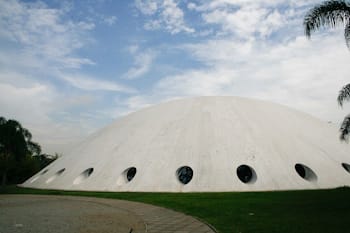
Niemeyer is one of the most important Latin American architect of the modern era. While the new Brazilian capital city of Brasilia is generally considered his crowning achievement, he has left his indelible mark on cities around the world. As his friend and mentor Le Corbusier once stated, "From the outset Niemeyer knew how to give full freedom to the discoveries of modern architecture". Many renowned contemporary architects cite him as an influence, including Norman Foster, Zaha Hadid, Daniel Libeskind, Bernard Tschumi, and Juergen Mayer. Upon hearing of his passing, Hadid stated "Oscar was a gentleman and a truly great architect - a virtuoso talent! His visionary work has had the deepest influence - with the highest degree of originality and spatial sensibility. It encouraged me to pursue my own architecture of total fluidity. Many architects experiment with shape, but Oscar pushed his work to a much higher level - using all the advantages of concrete to be poured into beautiful, fluid forms".
In Brasilia, and elsewhere in Brazil, Niemeyer developed a regional architectural language that would come to define the nation's identity in modern times. Goldberger writes, "Niemeyer was not just an architect who came from Brazil; he was Brazil, as much as Pele or the samba. [...] Niemeyer didn't compromise modernism's utopian ideals, but when filtered through his sensibility, the stern, unforgiving rigor of so much European modernism became as smooth as Brazilian jazz". Writing in a similarly vein, Ouroussoff states that "[Niemeyer's] curvaceous, lyrical, hedonistic forms helped shape a distinct national architecture and a modern identity for Brazil that broke with its colonial and baroque past. Yet his influence extended far beyond his country. Even his lesser works were a counterpoint to reductive notions of Modernist architecture as blandly functional". Ouroussoff also recognizes that "in celebrating both the formal elements and social aims of architecture, [Niemeyer's] work became a symbolic reminder that the body and the mind, the sensual and the rational, are not necessarily in opposition". Former Brazilian President Dilma Rousseff has said of Niemeyer that "few dreamed so intensely, and accomplished so much, as he did".
Influences and Connections
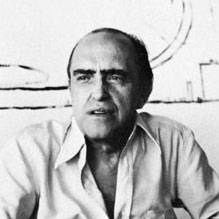
-
![Ludwig Mies van der Rohe]() Ludwig Mies van der Rohe
Ludwig Mies van der Rohe - Lúcio Costa
- Carlos Leão
- Gregori Warchavchik
-
![The International Style]() The International Style
The International Style -
![Brutalism]() Brutalism
Brutalism ![Modern Architecture]() Modern Architecture
Modern Architecture
-
![Norman Foster]() Norman Foster
Norman Foster -
![Zaha Hadid]() Zaha Hadid
Zaha Hadid -
![Daniel Libeskind]() Daniel Libeskind
Daniel Libeskind - Bernard Tschumi
- Juergen Mayer
![Modern Architecture]() Modern Architecture
Modern Architecture
Useful Resources on Oscar Niemeyer
- Oscar Niemeyer 1907-2012: The Once and Future DawnBy Philip Jodidio
- Oscar Niemeyer and Brazilian Free-Form ModernismOur PickBy David Kendrick Underwood
- Oscar Niemeyer: HousesBy Alan Hess
- The Revolution Will Be Stopped Halfway: Oscar Niemeyer in AlgeriaBy Jason Oddy
- Oscar Niemeyer and the Architecture of BrazilBy David Underwood
- Oscar Niemeyer in Algiers: The UnknownBy Matthias Flügge (Author), Sebastian Redecke
- Oscar Niemeyer (The Masters of World Architecture Series)Our PickBy Stamo Papadaki and William Alex
- Oscar Niemeyer: The Mondadori BuildingBy Robert Dulio
- Oscar Niemeyer: Curves of IrreverenceOur PickBy Styliane Philippou
 Ask The Art Story AI
Ask The Art Story AI








